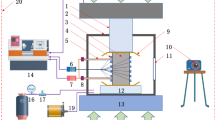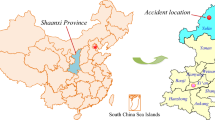Abstract
Coal remains an important fuel and energy, especially in China. For coal mining in deep mines, the threat of coal and rock dynamic disasters (such as coal and gas outburst) to safe production is becoming more and more serious with the greatly increasing geo-stress and gas pressure. Hence, it is particularly important to real-timely monitor and finely identify outburst-hazardous zones and their hazard levels during coal mining. However, conventional methods fail to continuously and precisely monitor outburst-hazardous zones in spatial distribution. Previous studies have shown that under the coupling action of stress and gas, the electric potential (EP) signals can be generated and their response characteristics are closely related to the loading state and damage evolution process of coal. The inversion imaging method can be utilized to analyze the spatial distribution of the EP signals. On this basis, the field tests were conducted to study the EP response characteristics to the mining process of deep coal seams and analyze the relationship between the EP response and outburst hazard. Moreover, in view of the EP inversion imaging mechanism, the bilateral EP inversion n model was established on the mining-disturbed coal seam ahead of the mining face and the field application was also carried out. Furthermore, on account of the membership index of fuzzy mathematics, the critical EP inversion value was proposed. Then the outburst-hazardous zones in the coal seam ahead of the mining face were divided finely and identified quantitatively. In the end, the verification result showed that the yellow zones enable to identify most of outburst-hazardous zones, thus effectively avoiding the missing identification. Besides, the red zones can improve the identification efficiency, which is conducive to focusing on identifying zones with a high hazard level. The study results provide a valuable new application method for finely identifying coal and gas outburst hazards and preventing coal and rock dynamic disasters in deep coal mines.
Highlights
-
The EP signals response can reflect the stress state and damage evolution of coal seams.
-
The bilateral EP inversion model was established ahead of mining face to reveal the electric field distribution characteristics.
-
The EP inversion results could identify the hazardous zones of dynamic disaster for coal and gas outburst in the coal seam.










Similar content being viewed by others
References
Archer JW, Dobbs MR, Aydin A, Reeves HJ, Prance RJ (2016) Measurement and correlation of acoustic emissions and pressure stimulated voltages in rock using an electric potential sensor. Int J Rock Mech Min Sci 89:26–33
Aydin A, Dobbs MR, Reeves HJ, Kirkham MP, Graham CC. Stress induced electric field measurements of different rock lithology using the Electric Potential Sensor 2013.
Clarkson CR, Bustin RM (1999) The effect of pore structure and gas pressure upon the transport properties of coal: a laboratory and modeling study. 2 Adsorption rate modeling. Fuel 78:1345–1362
Das AJ, Mandal PK, Paul PS, Sinha RK, Tewari S. Assessment of the Strength of Inclined Coal Pillars through Numerical Modelling based on the Ubiquitous Joint Model. Rock Mechanics and Rock Engineering 2019.
Haas AK, Revil A, Karaoulis M, Frash L, Hampton J, Gutierrez M et al (2013) Electric potential source localization reveals a borehole leak during hydraulic fracturing. Geophysics 78:D93-113. https://doi.org/10.1190/geo2012-0388.1
He X, Nie B, Chen W, Wang E, Dou L, Wang Y et al (2012) Research progress on electromagnetic radiation in gas-containing coal and rock fracture and its applications. Saf Sci 50:728–735
Jardani A, Dupont JP, Revil A. Self-potential signals associated with preferential groundwater flow pathways in sinkholes. Journal of Geophysical Research;111. https://doi.org/10.1029/2005jb004231.
Kong X, Li S, Wang E, Wang X, Zhou Y, Ji P et al (2021) Experimental and numerical investigations on dynamic mechanical responses and failure process of gas-bearing coal under impact load. Soil Dyn Earthq Eng 142:106579
Kozie K, Topolnicki J, Skoczylas N (2021) The intensity of heat exchange between rock and flowing gas in terms of gas-geodynamic phenomena. Entropy 23:556
Li Z, Niu Y, Wang E, Liu L, Wang H, Wang M et al (2019a) Experimental study on electric potential response characteristics of gas-bearing coal during deformation and fracturing process. Processes 7:72
Li Z, Niu Y, Wang E, He M (2019b) Study on electrical potential inversion imaging of abnormal stress in mining coal seam. Environ Earth Sci 78:255
Li L, Qin B, Liu J, Leong Y (2020a) Integrated experimentation and modeling of the formation processes underlying coal combustion-triggered methane explosions in a mined-out area. Energy 203:117855
Li H, Tian L, Huang B, Lu J, Shi S, Lu Y et al (2020b) Experimental study on coal damage subjected to microwave heating. Rock Mech Rock Eng 53:5631–5640
Li B, Wang E, Shang Z, Liu X, Li Z, Li B et al (2021) Optimize the early warning time of coal and gas outburst by multi-source information fusion method during the tunneling process. Process Saf Environ Prot 149:839–849
Liang Y, Cheng Y, Zou Q, Wang W, Ma Y, Li Q (2017) Response characteristics of coal subjected to hydraulic fracturing: an evaluation based on real-time monitoring of borehole strain and acoustic emission. J Nat Gas Sci Eng 38:402–411
Liu T, Lin B, Fu X, Gao Y, Kong J, Zhao Y, Song H (2020) Experimental study on gas diffusion dynamics in fractured coal: a better understanding of gas migration in in-situ coal seam. Energy 195:117005
Long HL, Hao JQ (2005) Theoretical and experimental research on self-potential tomography. Acta Geophys Sinica 48:1343–1349. https://doi.org/10.1002/cjg2.789
Mutke G, Lurka A, Zembaty Z. Prediction of rotational ground motion for mining-induced seismicity—Case study from Upper Silesian Coal Basin, Poland. Engineering Geology, 2020, 276:105767.
Na Z, Lior N, Jin H (2011) The energy situation and its sustainable development strategy in China. Energy 36(6):3639–3649
Niu Y, Li Z, Wang E, Shen R, Cheng Z, Gao X et al (2020) Study on characteristics of EP responsing to coal mining. Eng Fracture Mech 224:106780
Niu Y, Wang C, Wang E, Li Z (2019) Experimental study on the damage evolution of gas-bearing coal and its electric potential response. Rock Mech Rock Eng:1–16.https://doi.org/10.1007/s00603-019-01839-z.
Niu G, Zhang K, Yu B, Chen Y, Wu Y, Liu J (2019) Experimental study on comprehensive real-time methods to determine geological condition of rock mass along the boreholes while drilling in underground coal mines. Shock and Vibration
Noack K (1998) Control of gas emissions in underground coal mines. Int J Coal Geol 35:57–82
Onifade M. Towards an emergency preparedness for self-rescue from underground coal mines. Process Safety and Environmental Protection 2021.
Patella D (1997) Introduction to ground surface self-potential tomography. Geophys Prospect 45:653–681
Qin L, Li S, Zhai C, Lin H, Zhao P, Shi Y et al (2020) Changes in the pore structure of lignite after repeated cycles of liquid nitrogen freezing as determined by nitrogen adsorption and mercury intrusion. Fuel 267:117214
Qiu L, Song D, Li Z, Liu B, Liu J (2019) Research on AE and EMR response law of the driving face passing through the fault. Saf Sci 117:184–193
Revil A, Karaoulis M, Johnson T, Kemna A (2012) Some low-frequency electrical methods for subsurface characterization and monitoring in hydrogeology. Hydrogeol J 20:617–658
Rezaei M, Hossaini MF, Majdi A (2015) Determination of longwall mining-induced stress using the strain energy method. Rock Mech Rock Eng 48:2421–2433
Srivardhan V, Pal SK, Vaish J, Kumar S, Bharti AK, Priyam P (2016) Particle swarm optimization inversion of self-potential data for depth estimation of coal fires over East Basuria colliery, Jharia coalfield. India Environ Earth Sci 75:688
Trofimov VA, Filippov YA (2019) Influence of stress variation in roof rocks of coal seam on strata gas conditions in longwalling. J Min Sci 55:722–732
Wang C, Yang S, Yang D, Li X, Jiang C (2018) Experimental analysis of the intensity and evolution of coal and gas outbursts. Fuel 226:252–262
Xie H, Ju Y, Ren S, Gao F, Liu J, Zhu y, (2019) Theoretical and technological exploration of deep in situ fluidized coal mining. Front Energy 13:603–611. https://doi.org/10.1007/s11708-019-0643-x
Yi M, Wang L, Liu Q, Hao C, Wang Z, Chu P. Characteristics of Seepage and Diffusion in Gas Drainage and Its Application for Enhancing the gas utilization rate. Transport in Porous Media n.d.:1–15.
Zhai C, Xiang X, Xu J, Wu S (2016) The characteristics and main influencing factors affecting coal and gas outbursts in Chinese Pingdingshan mining region. Nat Hazards 82:507–530
Zhang Q, Zhang J, Kang T, Sun Q, Li W (2015) Mining pressure monitoring and analysis in fully mechanized backfilling coal mining face-A case study in Zhai Zhen Coal Mine. J Central South Univ 22:1965–1972
Zhang R, Liu J, Sa Z, Wang Z, Lu S, Wang C (2020) Experimental investigation on multi-fractal characteristics of acoustic emission of coal samples subjected to true triaxial loading–unloading. Fractals 28:2050092
Zou Q, Liu H, Zhang Y, Li Q, Fu J, Hu Q (2020) Rationality evaluation of production deployment of outburst-prone coal mines: a case study of nantong coal mine in Chongqing, China. Safety Sci 122:104515
Acknowledgements
This work is supported by the National Natural Science Foundation of China, China (52104234, 51774277), National Science Foundation for Young Scientists of Jiangsu Province (BK20210504), and the Fundamental Research Funds for the Central Universities (2021xQN1104).
Author information
Authors and Affiliations
Corresponding authors
Additional information
Publisher's Note
Springer Nature remains neutral with regard to jurisdictional claims in published maps and institutional affiliations.
Rights and permissions
About this article
Cite this article
Niu, Y., Wang, E., Li, Z. et al. Identification of Coal and Gas Outburst-Hazardous Zones by Electric Potential Inversion During Mining Process in Deep Coal Seam. Rock Mech Rock Eng 55, 3439–3450 (2022). https://doi.org/10.1007/s00603-022-02804-z
Received:
Accepted:
Published:
Issue Date:
DOI: https://doi.org/10.1007/s00603-022-02804-z




